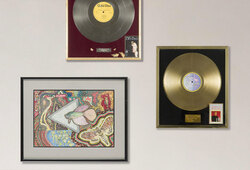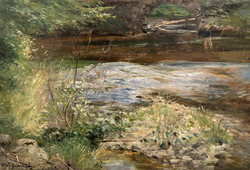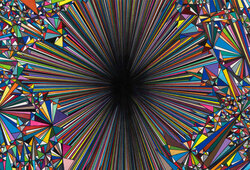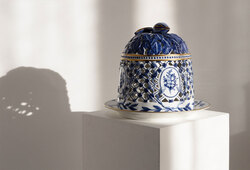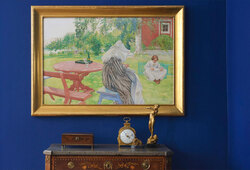Lucio Fontana
"Concetto Spaziale"
Signed L. Fontana on verso. Executed in 1964-65. Canvas 46 x 38 cm.
Provenance
Galerie Pierre, Stockholm, Sweden.
Private collection, Stockholm, Sweden (acquired from the above in the 1960s).
Literature
Enrico Crispolti, "Lucio Fontana - Catalogo Ragionato di sculpture, dipinti, ambientazioni Tomo II", 64-65 - O 8, p. 679.
More information
Certificate included, issued February 27, 2001, Fondazione Lucio Fontana, Milano, reg. no 2271-3.
The year 1949 marked a turning point in Lucio Fontanas career, he created the "Buchi", his first series of paintings in which he punctured the canvas. He also made his first spatial environment, a combination of shapeless sculptures, flourescent paintings, and black lights to be viewed in dark rooms. In 1950 he published the "Terzo manifesto spaziale, proposta per un regolamento" and 1951 he wrote the "Manifesto tecnico dello Spazialismo", both inspired by his origins as a sculptor and in search of a third dimension. During the 1950s he explored working with various effects, such as slashing and perforating in both painting and sculpture and partecipated in the Italian Art Informel exhibitions. In 1952 he took part in a competition for the "Fifth Door of the Cathedral of Milan" and was joint winner with Minguzzi and exhibited his completed spatial works at the Naviglio Gallery in Milan. Now, Fontana was no longer limiting himself to making holes in canvases, he was also painting them. During this period he also gained international acclaim outside Italy. "The discovery of the cosmos is a new dimension, it is infinity, so I make a hole in this canvas, which was at the basis of all the arts and I have created an infinite dimension .. the idea is precisely that, it is a new dimension corresponding to the cosmos..The hole is, precisely, creating this void behind there. Einstein's discovery of the cosmos is the infinite dimension, without end. And so here we have, foreground, middleground and background..to go farther what do I have to do ?.I make holes, infinty passes through them, light passes through them, there is no need to paint" (Enrico Crispolti,"Spatialism and Informel. The Fifties, pp 144-150 in Lucio Fontana, Milan 1998, p 146)If any of my discoveries are important, the "hole" is, By "hole" I meant going outside the limitations of a picture frame and being free in one's conception of art. A formula like 1+1=2. I did not make holes in order to wreck the picture. On the contrary, I made holes in order to find something else..I can talk about it today, because they were basically my ideas. They never understood. They used to say that I ripped up canvases, destroyed things and wanted to break the rules. But that's not true. Look at Pollock..I have argued with a few Americans. Once an American in Venice said to me, -"You're the spatialist but you don't understand about spaces. Who are you anyway?" Later he got to know me but did not understand anything. He found out that I am Fontana and am a spatialist. -"But how can you understand space ? We've got Arizona. There's space for you.." -So I said to him, -"Look, if it comes to that, I come from South America and we have the Pampas which is twice the size of Arizona. I am not interested in the kind of space you are talking about. Mine is a different dimension. The "hole" is this dimension.(T Trini, "The last interview given by Fontana", pp 34-36, 1988,
Designer
Up until the 1940s, Lucio Fontana lived and worked in Italy and France, but at the wake of the Second World War he fled to Argentina. In Buenos Aires at the Academia of Altamira, his idea of Spazialismo was born, a artist movement grounded by Fontana which came to define the majority of his career. In his manifesto from 1946, Manifesto Blanco, the artist challenged his peers to steer away from the tranditional and academic elements of art, urging them to include new techniques and darw to create art into the fourth dimension.
A great reasoning behind Fontana's popularity was his ability to combine sculpture and painting. His choice of forms was inconsistent during the entirity of his career, from geometirc perfections to more undefinable forms. It didn't matter so much about the end result, but rather the process it took to get there. Fontana's art was a product of its time, no matter the medium or technique.
Already in 1947, Fontana began working with the concept Concetto Spaziale. A few years later his Pietre series was added where he seemlessly combines sculpture and painting by applying thick layers of paint on a canvas and thereafter adding a collage of colourful glass chips. Not long after that Fontana entered a period with Buchi, where he made holes in the canvas to break up the two dimensionality of the composition in search for the space behind the painting. At the end of the 1950s he began his work with Tagli, whereby he sliced his canvas which continuously applying his Buchi technique, a style which he continued with up until his death in 1968. Through Concetto Spaziale, Fontana managed to blurr the lines between painting and sculpture.
His first Tagli was created at the end of the summer and early autumn of 1958 when Fontana was almost 60 years old. His canvases were filled with small diagonal incisions which he grouped together. Fontana experimented with size and form, and with time the slices became less and more powerful. To reach the right effect, Fontana was incredibally precise with the surface of the canvas, coating it first with a matt, often water based, monochrome colour. His pieces with only one slice are marked as "Attesa" and the canvases with multiple slices are marked with the plural form, "Arrese". The meaning "expectation or hope" gives an additional dimension to the work. Fontana covered the back piece with "telleta," strips of deep black fabric to create the illusion of an empty space behind the canvas. In Tagli, destruction and creation merge. Every slice is formulated through a definitive and irreversable gesture. Every action which results in a wound upon the canvas simultaneously allows for a new sculptural perspective out into the black neverending space behind the canvas. Fontana's artistic journey with Tagli and Buchi happened correspondingly with the 1960s space race.
"As an artist, when I work with one of my perforated canvases, I have no desire to create a painting; I want to create an opening for space, to give art a new dimension, to bind it to the cosmos, as it endlessly continues beyond the boundaries of the painting. With my innovation of holes drilled through the canvas in repeated formations, I do not wish to decorate a surface, but rather to break up its dimensional limitations. Behind the perforations lies a newfound freedom for interpretation, but also, just as inevitably, an end to art." (Lucio Fontana, 1966)
Fontana came and had several exhibitions in Sweden during the 1960s. One of his greatest admirers was the gallerist Pierre Lundholm at Galerie Pierre in Stockholm who not only arraned exhibitions in 1964, 1967, and after Fontana's death in 1971, but also stored and sold Fontana's work. Fontana even managed to exhibit at the Swedish French Art Gallery in 1965 as well as have a large exhibition at Moderna Museet in 1967 in Stockholm through the initiative of Pontus Hultén. His paintings were admired by the most asteemed collectors, and with the wider public, his works were preceived as bizzar and incomprehensible. Today Lucio Fontana is praised for his art that stood as a testament beyond his time.
Read more





